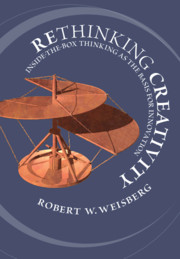Book contents
- Rethinking Creativity
- Rethinking Creativity
- Copyright page
- Dedication
- Contents
- Figures
- Tables
- Part I Introduction
- Part II Analytic Thinking in Creativity
- 3 Problem-Solving
- 4 Case Studies of Creativity
- 5 Analogical Thinking in Problem-Solving and Creativity
- Part III The Question of Extraordinary Thought Processes in Creativity
- Part IV The Psychometrics of Creativity
- Part V The Neuroscience of Creativity
- References
- Index
3 - Problem-Solving
from Part II - Analytic Thinking in Creativity
Published online by Cambridge University Press: 01 October 2020
- Rethinking Creativity
- Rethinking Creativity
- Copyright page
- Dedication
- Contents
- Figures
- Tables
- Part I Introduction
- Part II Analytic Thinking in Creativity
- 3 Problem-Solving
- 4 Case Studies of Creativity
- 5 Analogical Thinking in Problem-Solving and Creativity
- Part III The Question of Extraordinary Thought Processes in Creativity
- Part IV The Psychometrics of Creativity
- Part V The Neuroscience of Creativity
- References
- Index
Summary
Problem-solving, an important example of creative thinking, is discussed in Chapter 3. The chapter begins with example of real-world problem-solving that had enormous historical consequences: the rescue in 1941 of the British army from the beaches at Dunkirk. The chapter then examines details of problem-solving, using three already-familiar creative advances: the Dunkirk rescue, just discussed; and IDEO’s shopping cart and Picasso’s Guernica, from Chapter 1. Problem-solving is a core component of analytic thinking, so the chapter examines in detail what we mean when we talk about “analytic thinking.” That discussion provides a set of concepts to use when we examine problem-solving and creative thinking throughout the book. We then turn to an examination of laboratory research on problem-solving to provide a more formal description of the processes involved. Again, analogy is seen as critically important in creative thinking. Finally, we reconsider the mechanisms underlying “green” creativity during problem-solving – generating a possible solution and extending the old idea to the new situation. In this chapter, we consider the relevance of those mechanisms to other situations.
Keywords
- Type
- Chapter
- Information
- Rethinking CreativityInside-the-Box Thinking as the Basis for Innovation, pp. 75 - 111Publisher: Cambridge University PressPrint publication year: 2020



